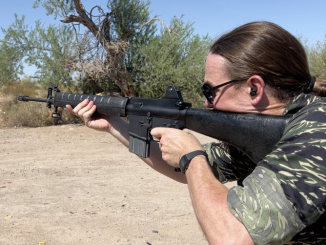In the mid 1950s, the Nationalist government on Taiwan was in serious need of small arms, and decided to set up production of the Sten gun. They had the facilities of the 44th Arsenal outside Taipei, which had been relocated there from the mainland in 1948. For some assistance, the government hired a US Army officer as a consultant, and as part of the production setup, they built half a dozen miniature but fully-functional Stens in .32ACP. One of these came home with the US officer, and was registered in the 1968 Amnesty.
The magazine well has the proper symbol of the 44th Arsenal, and they gun has two specific irregularities compared to a standard British Sten. The fire control housing is triangular instead of rounded, and it has no semiauto selector switch. These features carried through to the fully production guns, as one can see on an example in the British Royal Armouries today.


I hope shooting it video tomorrow LOL
Awesome! I hope you get to take it to the range.
1) The distant bang you heard was the CHICOM’s going into orbit on hearing “Taiwan” and “independent state” in the same sentence. Bravo, Ian!
2) Maybe an assassination weapon for hit squads of ROC special forces?
“(…)Maybe an assassination weapon for hit squads of ROC special forces?(…)”
Err… but if it would be case why would they select finish: shiny?
We’re can I get one
You dump enough 32 acp into a chest cavity and it will do your job.
Very cool, but too bad they only made these as demonstrators. A larger (but still lighter and more compact than the original) .32 STEN could have been an exceptionally handy and controllable urban combat weapon, particularly for use by (and against) smaller-statured troops.
If you need simple .32 Auto sub-machine gun then consider Owen .32ACP prototype submachine gun, see 1st photo from top https://modernfirearms.net/en/submachine-guns/australia-submachine-guns/owen-machine-carbine-owen-gun-eng/
Ginormous, and hideous AF – but very interesting, thanks!
Oooooh ! If I’d had this when I was 6! Timeline is right.
I sense how Ian is loosing control of his passion… 🙂
So when we go to range?
Years ago there was a 9mm MK11 sten converted to single shot .22LR for sale at a gunshow here in France.Also done in the 50’s
The reinforcement at the top of a STEn mag is a direct copy from the schmiesser patented German mag.
Narrow groves and broad lands, is unusual
However, American rifling styles do tend to have very narrow lands, typically one third of the width of the grooves
The M1917 “Enfield” copied the rifling proportions of the P14, with equal width grooves and lands, but with a .300″ bore and .308 grooves.
It had less cross sectional area than a 1903 barrel, but appeared to have a longer life, and didn’t give noticeable problems with pressure.
I guess that the actual lower limit to groove width arrives when the the bits of bullet going into the grooves are too narrow and shear off, rather than spin the bullet
Or don’t fill the groove to the bottom, and allow gas to blow past.
I like it. You have a small James Bond, call him Jimbo, and a tiny sten, call it the wee-sten. Ernst Blofeld opens his mailbox, saying to himself, “I can’t wait for my Readers Digest! Ahh! A tiny 007!” Jimbo gives him a long burst, hops out of the mailbox with his smoking wee-sten and grins. “Everyone loves a short story.”
I wonder if they meant to arm children in case of an invasion.
Please don’t suggest that lightly. My parents (both Taiwanese) were conscripted during their high-school years. At no time were they given .32 ACP Sten guns. They had been issued old Type 24 rifles and bayonets. Now let that sink in.
Given a pistol grip and a folding stock like the Austen, the result would have been an analogue of the Czech Vz61 “Skorpion” in 7.65mm Browning.
Like the Skorpion, it might have made a useful PDW for vehicle crews, being more compact than the full-grown Sten MK II but still hitting with some authority.
cheers
eon
Nobody should survive getting a full magazine of 7.65mm Browning shot into his forehead at contact range. Yes, I was recommending cruel overkill if some nut job ripped out the entry hatch on your tank.
“Given a pistol grip and a folding stock like the Austen, the result would have been an analogue of the Czech Vz61 “Skorpion” in 7.65mm Browning.(…)”
Maybe, to get that effect, do dwarf STEN Mk.IV, see 5th image from top:
https://modernfirearms.net/en/submachine-guns/great-britain-submachine-guns/sten-eng/
?
Ian, I need you to wield it in a backup gun match.
Perhaps this is something for a “gift to a good person.”
Because it can be neither a normal weapon, nor a technological sample.
The workers of the Izhevsk plant gave MT Kalashnikov a good-looking toy, AK47 on a scale of 1:3, for some anniversary.
There were even bullets for shooting. I don’t know if it fired, but the cartridges looked like real ones (only small).
If this info is correct, then this sample was stolen from him.
I wonder if this will pop up at some kind of auction, over time…
As for the narrow grooves of the rifling, it seems to be the same approach Marlin uses for their famous (and successful) Micro-Groove rifling. Easier to cut and works just as well.